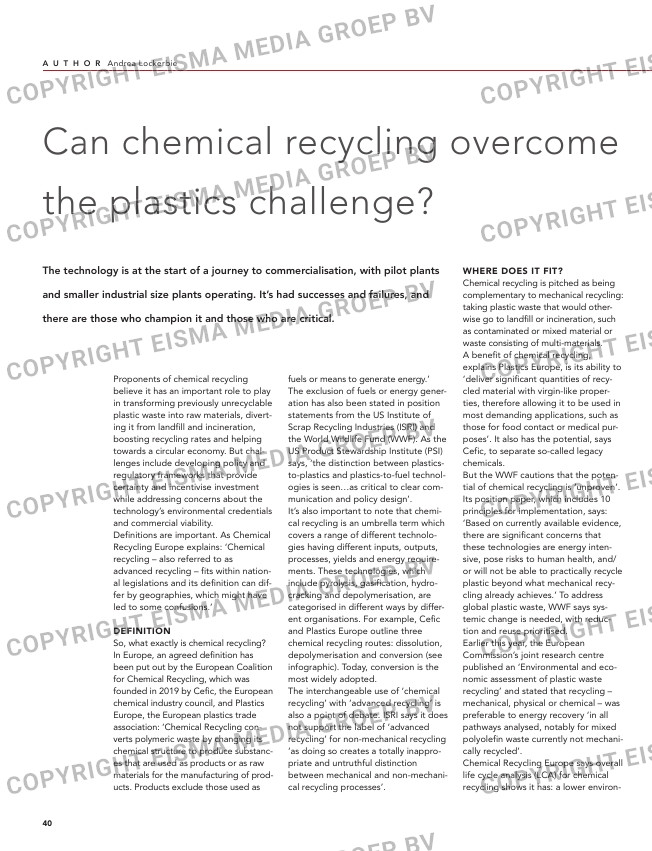Page 40 from: Recycling International – free September/October Issue

40
Can chemical recycling overcome
the plastics challenge?
The technology is at the start of a journey to commercialisation, with pilot plants
and smaller industrial size plants operating. It’s had successes and failures, and
there are those who champion it and those who are critical.
mental impact than incineration with
energy recovery; a lower environmen-
tal impact than making plastics or spe-
cialty chemical products from fossil
sources; and tends to have a higher
environmental impact than mechanical
recycling, although it varies between
technologies and plastic streams treat-
ed.
There has been debate around LCAs
and as Mark Victory, senior editor for
recycling at Independent Commodity
Intelligence Services (ICIS), explained
on its podcast ‘a widespread range of
independent, comparable LCAs that
go cradle-to-grave’ are needed for
more definitive answers.
Plastics Recyclers Europe (PRE) adds:
‘Energy consumption, the overall envi-
ronmental impact and efficiency will be
key in determining the processes via
which plastic waste should be pro-
cessed to satisfy the required product
specifications.’
LEVERS AND CHALLENGES
At a global level, steps to address plas-
tic waste are being taken in the form of
the United Nations Global Treaty to
End Plastic Pollution, which UN mem-
Proponents of chemical recycling
believe it has an important role to play
in transforming previously unrecyclable
plastic waste into raw materials, divert-
ing it from landfill and incineration,
boosting recycling rates and helping
towards a circular economy. But chal-
lenges include developing policy and
regulatory frameworks that provide
certainty and incentivise investment
while addressing concerns about the
technology’s environmental credentials
and commercial viability.
Definitions are important. As Chemical
Recycling Europe explains: ‘Chemical
recycling – also referred to as
advanced recycling – fits within nation-
al legislations and its definition can dif-
fer by geographies, which might have
led to some confusions.’
DEFINITION
So, what exactly is chemical recycling?
In Europe, an agreed definition has
been put out by the European Coalition
for Chemical Recycling, which was
founded in 2019 by Cefic, the European
chemical industry council, and Plastics
Europe, the European plastics trade
association: ‘Chemical Recycling con-
verts polymeric waste by changing its
chemical structure to produce substanc-
es that are used as products or as raw
materials for the manufacturing of prod-
ucts. Products exclude those used as
fuels or means to generate energy.’
The exclusion of fuels or energy gener-
ation has also been stated in position
statements from the US Institute of
Scrap Recycling Industries (ISRI) and
the World Wildlife Fund (WWF). As the
US Product Stewardship Institute (PSI)
says, ‘the distinction between plastics-
to-plastics and plastics-to-fuel technol-
ogies is seen…as critical to clear com-
munication and policy design’.
It’s also important to note that chemi-
cal recycling is an umbrella term which
covers a range of different technolo-
gies having different inputs, outputs,
processes, yields and energy require-
ments. These technologies, which
include pyrolysis, gasification, hydro-
cracking and depolymerisation, are
categorised in different ways by differ-
ent organisations. For example, Cefic
and Plastics Europe outline three
chemical recycling routes: dissolution,
depolymerisation and conversion (see
infographic). Today, conversion is the
most widely adopted.
The interchangeable use of ‘chemical
recycling’ with ‘advanced recycling’ is
also a point of debate. ISRI says it does
not support the label of ‘advanced
recycling’ for non-mechanical recycling
‘as doing so creates a totally inappro-
priate and untruthful distinction
between mechanical and non-mechani-
cal recycling processes’.
WHERE DOES IT FIT?
Chemical recycling is pitched as being
complementary to mechanical recycling:
taking plastic waste that would other-
wise go to landfill or incineration, such
as contaminated or mixed material or
waste consisting of multi-materials.
A benefit of chemical recycling,
explains Plastics Europe, is its ability to
‘deliver significant quantities of recy-
cled material with virgin-like proper-
ties, therefore allowing it to be used in
most demanding applications, such as
those for food contact or medical pur-
poses’. It also has the potential, says
Cefic, to separate so-called legacy
chemicals.
But the WWF cautions that the poten-
tial of chemical recycling is ‘unproven’.
Its position paper, which includes 10
principles for implementation, says:
‘Based on currently available evidence,
there are significant concerns that
these technologies are energy inten-
sive, pose risks to human health, and/
or will not be able to practically recycle
plastic beyond what mechanical recy-
cling already achieves.’ To address
global plastic waste, WWF says sys-
temic change is needed, with reduc-
tion and reuse prioritised.
Earlier this year, the European
Commission’s joint research centre
published an ‘Environmental and eco-
nomic assessment of plastic waste
recycling’ and stated that recycling –
mechanical, physical or chemical – was
preferable to energy recovery ‘in all
pathways analysed, notably for mixed
polyolefin waste currently not mechani-
cally recycled’.
Chemical Recycling Europe says overall
life cycle analysis (LCA) for chemical
recycling shows it has: a lower environ-
Post-consumer plastic waste is used in the Quantafuel plant with any PVC, ABS, PA and lesser-used polymer types removed.
A U T H O R Andrea Lockerbie
40-41-43-45-47-48_chemicalvsmechanical.indd 40 12-09-2023 16:12



